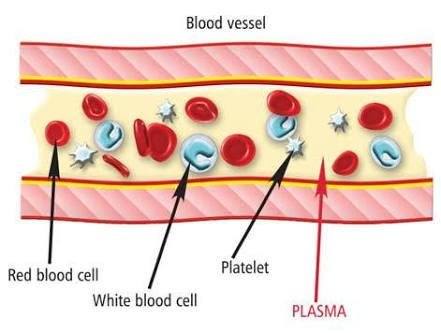1. Blood Function
Blood and circulatory system of several functions as follows.
- Transporting important materials throughout the body. Some important materials are transported by blood, ie organic and inorganic nutrients and gases, such as oxygen. Nutrients or food substances that come from outside the body will go into the digestive equipment, then circulated by blood to all cells. Meanwhile, oxygen is transported from the lungs to the entire body cells for subsequent use in the process of oxidizing nutrients.
- Transporting waste products out of the cell and discharged or expelled (environment). These waste products include carbon dioxide and waste substances (waste) metabolism. Carbon dioxide is the result of oxidation and will be transported from the body's cells outward to the lungs. Substances of metabolic waste are removed from the body's cells to the kidneys.
- Carries hormones from the endocrine glands to the cells or tissues that are targeted.
- Transporting buffered molecules to maintain blood pH.
- Transporting enzymes from secretory cells to other body cells.
- Maintain body temperature by transporting heat from the inside of the body to the surface of the body or vice versa.
- To transport antibodies to the site of infection to be neutralized.
2. Blood Component
Blood is divided into two main components, namely blood plasma and blood cells. How do we know and see the two components of the blood? Blood components can be obtained by centrifugation. Centrifugation is a way of rotating blood samples in a tube using high speed. When the blood sample is centrifuged it will form three layers of blood.
a. Blood plasma
Blood plasma is a fluid part of the blood, filling about 55% of the blood volume. In the blood plasma, the substances dissolved with water. The main function of blood plasma is to regulate the balance of blood osmosis in the body. Here is the composition of blood plasma and its derivatives.
b. Blood Cells
Between 40% -50% of human blood volume are blood cells. Blood contains several types of blood cells that have different functions. There are three kinds of blood cells, namely white blood cells (leukocytes), red blood cells (erythrocytes), and blood chips (thrombocytes).
1. Leukocytes
In the blood plasma on a sample of blood that is centrifuged there is a thin layer, the leukocytes or better known as white blood cells. Leukocytes develop from the inside (bone marrow) of certain bones in the body. Leukocytes help the body fight various infectious diseases, as part of the immune system. Leukocyte cells are colorless, can move amoeboid, and can penetrate capillary / diapedesis wall. Leucocytes have cell nuclei that can survive for months. In the body, leukocytes work independently like single cell organisms. Leucocytes are able to move freely and interact and capture cellular fragments, foreign particles, or intruder microorganisms.
2. Erythrocytes
At the bottom of the base layer of blood samples are erythrocytes, the red blood cells. Erythrocytes work to transport oxygen throughout the body. When compared with white blood cells, the number of red blood cells multiplies than the number of white blood cells contained in the circulatory system. Like leukocytes, red blood cells originate from a cell in the bone marrow.
The ability to bind oxygen and carbon dioxide by red blood cells is due to the presence of hemoglobin. Hemoglobin is a protein that has a strong binding force against oxygen and carbon dioxide.
3. Thrombocytes
The next blood component is a platelet blood or better known as thrombocytes. This blood component can not be seen in the blood samples are centrifuged because the amount is very small. Just like leukocytes and erythrocytes, blood or platelets are formed in the bone marrow. Thrombocytes have a very crucial role in the cessation of bleeding when the body is injured. Thrombocytes have an irregular, colorless, non-core, small form of erythrocytes and leukocytes, and are easily broken when touched by abrasive.3. Blood Clotting Process
If a blood vessel is injured, the blood will be injured. The body has a way of freezing the blood out gradually so that the bleeding will stop.
When the blood discharges through the broken blood vessels, the thrombocytes will break. Thrombocytes will produce thromboplastin or thrombokinase enzymes and mix with blood plasma. In the blood plasma there are prothrombin and fibrinogen.
The thromboplastin enzyme will activate the protombin into thrombin. In the activation process also involves calcium ions (Ca2+), vitamin K and other factors. Trombin acts as an enzyme that can convert fibrinogen into fibrin. Fibrin is a fiber that will weave the surface of the wound to stop the bleeding.
Source :


Source: http://www.biologisma.com/2016/12/darah-fungsi-komponen-dan-proses.html
Not indicating that the content you copy/paste is not your original work could be seen as plagiarism.
Some tips to share content and add value:
Repeated plagiarized posts are considered spam. Spam is discouraged by the community, and may result in action from the cheetah bot.
Creative Commons: If you are posting content under a Creative Commons license, please attribute and link according to the specific license. If you are posting content under CC0 or Public Domain please consider noting that at the end of your post.
If you are actually the original author, please do reply to let us know!
Thank You!
Downvoting a post can decrease pending rewards and make it less visible. Common reasons:
Submit